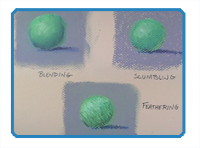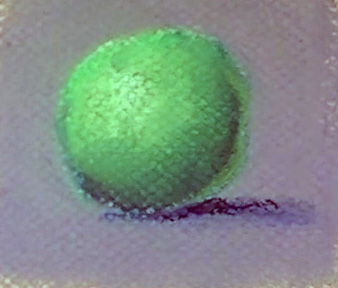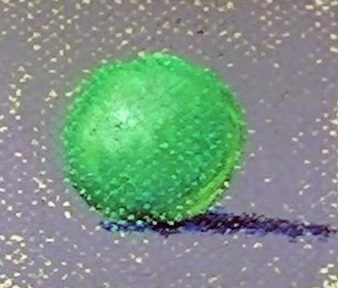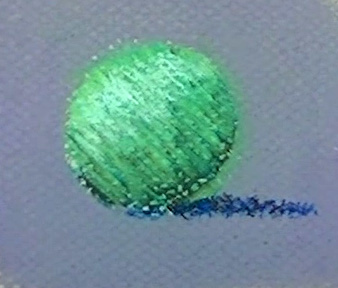
By Matt Fussell
There are countless ways that pastels can be applied to a drawing surface. There are, of course, no “right ways” or “wrong ways”. The artist should simply choose the technique that is appropriate for the desired effect.
For nearly all pastel drawings, a combination of these techniques will be used.
A few of the more common techniques for applying soft pastels include: blending, scumbling, and feathering. Each of these techniques produces a different effect on the surface. Let’s take a look at each one of these techniques a bit more in detail...
 Perhaps the most common technique for applying pastels is blending. Blending occurs when pastels are applied in layers on a surface. Transitions between colors and values are smoothed by smearing or rubbing the pastel into the surface. The results are smooth gradations of value and color on objects.
Perhaps the most common technique for applying pastels is blending. Blending occurs when pastels are applied in layers on a surface. Transitions between colors and values are smoothed by smearing or rubbing the pastel into the surface. The results are smooth gradations of value and color on objects.
Blending can be accomplished using a finger, blending stump, cotton swab, or a rolled up piece of paper. Other tools include protective gloves for fingers. (Blending with the fingers is often referred to a “smudging”.)
For large areas, I prefer to use my finger to blend, but for smaller and more precise areas, a blending stump works best. Blending stumps can be purchased at a reasonable price at a local art store, but you can substitute one for a rolled up piece of paper or paper towel.
 Scumbling is a technique for applying pastels in which light, but opaque applications of pastel are layered over the top of areas within the picture plane. These areas may have already received an application of pastel or they may be partially covering the raw surface of the paper.
Scumbling is a technique for applying pastels in which light, but opaque applications of pastel are layered over the top of areas within the picture plane. These areas may have already received an application of pastel or they may be partially covering the raw surface of the paper.
When scumbling is used, optical color mixing typically occurs. Optical color mixing is when colors positioned next to each visually “mix” to cause a perception of a new color. For example, if yellow marks are positioned next to, or on top of blue marks - the perceived color by the viewer may be green.
As you can imagine, the physical texture - or tooth of the paper, plays an important role in the effect that is achieved. Since scumbled marks are generally applied lightly, the texture of the paper will “pick up” the material in areas where it is raised, leaving the color underneath in the recesses of the texture. Scumbling, of course, still happens in drawings that are completed on smooth surfaces. Surface texture is not the only factor that effects the scumbling process, but it should be considered.
 Feathering is a technique for applying pastels in which the material is added in a linear fashion. The lines that are created may follow the cross contours of the subject, adding to the illusion of form - but they don’t have to. Feathered lines may overlap, cross over each other, or be wide. Generally, the lines are short, but this is not a rule. Feathering is simply another method of applying pastels through layers of color.
Feathering is a technique for applying pastels in which the material is added in a linear fashion. The lines that are created may follow the cross contours of the subject, adding to the illusion of form - but they don’t have to. Feathered lines may overlap, cross over each other, or be wide. Generally, the lines are short, but this is not a rule. Feathering is simply another method of applying pastels through layers of color.
With each linear application of pastel, the color grows in depth and communicates the form of the object more clearly.
Some mixing of the colors is to be expected as layers are added. Like with scumbling, optical color mixing will occur as well.
NOTE: For feathering techniques, it is advisable to use hard pastels or pastel pencils. Because these materials are harder, they will hold a sharper tip for a longer period of time and lead to more precise and controlled lines. This is not absolutely necessary, since soft pastels can be used to create feathering effects as well.Again, for most drawings, a combination of the three techniques discussed here will be used in an image. It is essential to incorporate a variety of marks in any drawing.
No matter which technique is used, the goal should be to build up developed layers of pastel on the surface. This creates depth in color and furthers the illusion of form. These methods offer a few ways to achieve this goal and develop the drawing into a cohesive and successful pastel painting.
Here are some more art lessons that you may like...